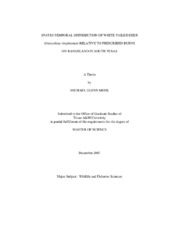| dc.contributor.advisor | Cooper, Susan M. | |
| dc.creator | Meek, Michael Glenn | |
| dc.date.accessioned | 2010-01-15T00:05:28Z | |
| dc.date.accessioned | 2010-01-16T00:45:14Z | |
| dc.date.available | 2010-01-15T00:05:28Z | |
| dc.date.available | 2010-01-16T00:45:14Z | |
| dc.date.created | 2007-12 | |
| dc.date.issued | 2009-05-15 | |
| dc.identifier.uri | https://hdl.handle.net/1969.1/ETD-TAMU-2616 | |
| dc.description.abstract | Overgrazing and fire suppression has left much rangeland in poor condition for
various wildlife species. Prescribed fire is one range improvement practice used to
restore degraded wildlife habitat. I determined the effect of prescribed fire on whitetailed
deer (Odocoileus virginianus) spatial and temporal distribution, in the presence of
cattle grazing. Three 40 ha patches, constituting 10% and 6% of the land area in the
lesser and greater Yellow Bluff pasture, respectively, were burned in September 2005.
To determine habitat use and distribution of deer relative to these burns 3 bucks and 3
does were netted from a helicopter and fitted with Global Positioning System (GPS)
telemetry collars (Lotek™ GPS_3300S) for a period of 30 days during each season. For
estimation of spatial distribution of deer, the collars were programmed to take a position
fix every hour to reduce problems associated with spatial autocorrelation. For 12 days
within this period the collars recorded animal location every 5 minutes to compare
habitat use with 6–9 GPS collars (GPS_3300LR) placed on cattle. This allowed me to
examine fine-scale movements of deer relative to cattle. Trials were conducted prior to the burn and in each season for one year after the
burn. Areas to be burned were not favored by deer. A month after the burn in Fall 2005
there was an increase in use of the burned areas by deer. Deer preference for burned
areas fell in Spring and Summer 2006, but in Fall 2006 females dramatically increased
their use of the burns. This is possibly an artifact of small sample size and the random
selection of individuals. Interaction between deer and cattle was minimal, as they
inhabited different areas. When cattle moved within approximately 50 m of a stationary
deer the deer was likely to move away. Vegetation measurements showed no significant
change in shrub cover and density and a decline in available herbaceous forage on both
treatment and control sites in the second year. The lack of vegetative response because
of drought conditions was likely the cause of the lack of response by the deer to the
burns. | en |
| dc.format.medium | electronic | en |
| dc.format.mimetype | application/pdf | |
| dc.language.iso | en_US | |
| dc.subject | white-tailed deer | en |
| dc.subject | Odocoileus virginianus | en |
| dc.subject | prescribed burning | en |
| dc.subject | cattle | en |
| dc.subject | rangeland restoration | en |
| dc.subject | GIS | en |
| dc.subject | GPS | en |
| dc.title | Spatio-temporal distribution of white-tailed deer (Odocoileus virginianus) relative to prescribed burns on rangeland in South Texas | en |
| dc.type | Book | en |
| dc.type | Thesis | en |
| thesis.degree.department | Wildlife and Fisheries Sciences | en |
| thesis.degree.discipline | Wildlife and Fisheries Sciences | en |
| thesis.degree.grantor | Texas A&M University | en |
| thesis.degree.name | Master of Science | en |
| thesis.degree.level | Masters | en |
| dc.contributor.committeeMember | Lopez, Roel R. | |
| dc.contributor.committeeMember | Owens, M. Keith | |
| dc.type.genre | Electronic Thesis | en |
| dc.type.material | text | en |
| dc.format.digitalOrigin | born digital | en |


